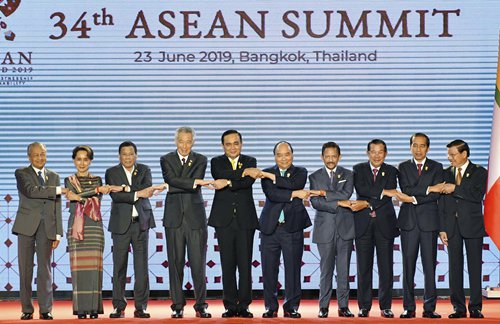HOME >> OPINION
ASEAN summit seeks certainty amid change
By Yu Qun Source:Global Times Published: 2019/7/2 18:13:42

Photo: VCG
The recently wrapped-up ASEAN summit brought to the fore issues surrounding security, society and culture in Southeast Asia with the theme "Advancing Partnership for Sustainability" underpinning discussions in the Thai capital Bangkok.
The 34th meeting of the 10-member grouping sought to build an ASEAN Community that is centered around people and is futuristic.
The agenda and documents embody the ASEAN members' ability to lay down development policies in the face of crisis and regional uncertainty. The 10 countries that bring together 640 million people will continue to gain in strength and help centripetal forces within the ASEAN Community. Externally, they aim to strengthen coordination and interaction with dialogue partners and consolidate the centrality of ASEAN. Through both internal and external mechanisms, ASEAN strives to transform "uncertainty" into "certainty."
In terms of ASEAN Community building, the bloc hopes to strengthen internal cooperation and promote community development in three aspects. The first is the formation of "ASEAN Consciousness" through stepped-up cultural exchanges.
Piti Sriseangnam, director of academic affairs at the ASEAN Studies Center in Bangkok-based Chulalongkorn University, told media that the biggest surprise for the public was that ASEAN leaders agreed to launch joint bid to host 2034 FIFA World Cup. This is not only a special way to build the ASEAN Community, but also a major achievement.
Second, in face of a worsening marine environment, ASEAN wants to improve disaster relief capacity. According to 2015 data released by Ocean Conservancy, a US-based environment group, about 8 million tons of plastic waste are dumped into the world's oceans every year. More than half of this waste comes from China, Indonesia, the Philippines, Vietnam and Thailand and led to deteriorating marine ecology in the region. The summit adopted the Bangkok Declaration on Combating Marine Debris in ASEAN Region. Chairing the summit, Thai Prime Minister Prayut Chan-o-cha said the declaration showed ASEAN's sincerity toward addressing marine pollution, adding that ASEAN would work together and "leave no one behind."
The Satellite Warehouse under the Disaster Emergency Logistics System for ASEAN as well as the upgrade of ASEAN Center of Military Medicine serve as concrete manifestations of this spirit.
Third, ASEAN is actively involved in the Rohingya issue in Myanmar and is seeking a resolution of the ethnic conflict. The Rohingya crisis, which broke out in 2017, has affected many ASEAN members such as Malaysia and Thailand, and has quickly become an ethnic flash point. The issue has been a stumbling block in the creation of the ASEAN Community. ASEAN leaders expressed concern about the issue at the summit and called for repatriation of Rohingya refugees. The involvement has significantly changed the image of the ASEAN summit to the moniker "NATO" - No Action Talk Only.
As for external collaboration, the summit came up with three achievements this year, a manifestation of ASEAN's independent diplomacy.
First, the bloc vowed to fight protectionism and support multilateral trade. It is determined to complete negotiations this year for the Regional Comprehensive Economic Partnership (RCEP). US President Donald Trump has been advocating unilateralism and scoffed at globalization after taking office. He launched the largest trade war in history and imposed maximum pressure on China. The fierce trade tensions between the two largest economies have had a deep impact on ASEAN members. ASEAN's active promotion of the RCEP will help mitigate such trade tensions.
What's more, the RCEP is expected to become the largest free trade area in the world, helping drive economic and social development.
Second, negotiations on the Code of Conduct (COC) on the South China Sea are going quite smooth. The summit statement welcomed continued cooperation with China and said the organization has been encouraged by progress of negotiations toward the COC within an agreed timeline. It is expected that the first draft of the COC will be ready this year.
US Assistant Secretary of Defense for Indo-Pacific Security Affairs Randall Schriver said that choosing the US over China as a partner is the logical choice for ASEAN. He was speaking at the 35th anniversary gala dinner of the US-ASEAN Business Council in mid June. But ASEAN does not do America's bidding. Instead, it has enhanced cooperation with China on the South China Sea issue.
As a result of US pressure, there is a growing need for unity inside ASEAN. However, the paradox is that the US knows coercing others will only bring resistance but it is the only tactic it chooses to use.
Third, the ASEAN Outlook on the Indo-Pacific was adopted. It emphasizes ASEAN centrality and plays down military confrontation. The US-led Indo-Pacific Strategy aims to draw in ASEAN members and encircle China through military cooperation among the US, Japan, India and Australia. However, ASEAN seems not interested in the initiative. Instead, it has put forward the Indo-Pacific Outlook with ASEAN characteristics.
Guided by the Cold War mentality, the Indo-Pacific Strategy is exclusive and confrontational. Differently, the ASEAN-led Outlook on the Indo-Pacific is characterized by sustainability, inclusiveness and cooperation. It highlights economic and social development rather than political and security alliance.
Uncertainty is escalating in the region and the world. ASEAN focuses on livelihood issues and enhancing internal strength, seeking to promote external cooperation and independent diplomacy. ASEAN aims to turn uncertainty into certainty by seeking stability in a volatile environment.
The author is deputy director at the Military Diplomacy Research Center of the College of International Studies, National University of Defense Technology. opinion@globaltimes.com.cn
Posted in: